- Call us: 01444 237070
- Contact Us
- Stores
- Sign In / Register
-
- Back
- Used Cameras
- Used Accessories
- Used Lenses
- Used Video
- Used Film Equipment
- Used Stock Alert
- Used Blank Test
- Sell or Part Exchange
- Used Clearance
- Recently Added Used Equipment
- Park Picks
- All Used Black Friday Deals
- Faulty
- Trade-In
- Blog
- New in
- Call us
- Contact us
- Stores
- Sign in
- Categories
- Tips & Inspiration
- Reviews
- News
- Events
- Features
- Buying Guides
- Competitions
Sony FX3 Vs a7S III Vs FX6 Comparison
If you’re wondering which Sony video camera best suits your needs read this post where we review and compare three of the latest full frame video-centric cameras. Our quick comparison table shows key specs from the new Sony FX3 Cinema Camera, a7S III mirrorless camera as well as the FX3’s big brother, the FX6 Cinema Camera.

Sony brings a considerable level of experience with pro cinema movie making to it’s consumer line-up of video-centric cameras. The release of extremely capable full frame models such as those discussed here highlight this trend, with less of a technology trickle-down and more of a raging flood. Independent film makers and vloggers are particularly spoilt for choice right now and we hope to dissect these three video cameras to make choosing between them a little bit easier.
|
Sensor Megapixels |
10.2MP |
12.1MP |
10.2MP |
|
Processor |
Bionz XR |
Bionz XR |
Bionz XR |
|
Maximum Resolution |
QFHD / S35: FHD |
QFHD / S35: FHD |
DCI-4K and QFHD / S35: FHD |
|
Maximum Frame Rate |
4K 120p / FHD 240p |
4K 120p / FHD 240p |
4K 120p / FHD 240p |
|
Maximum Bit Rate |
10-Bit 4:2:2, Long GOP. All-I H.264, H.265 |
10-Bit 4:2:2, Long GOP. All-I H.264, H.265 |
10-Bit 4:2:2, Long GOP. All-I H.264 |
|
Raw Via HDMI |
16-Bit RAW |
16-Bit RAW |
16-Bit RAW (12G) |
|
ISO Range |
ISO 80-409,600 |
ISO 80-409,600 |
ISO 800/12800 |
|
Image Stabilisation |
5 Axis |
5 Axis |
N/A |
|
Variable ND |
N/A |
N/A |
YES (1/4 - 1/128) |
|
Viewfinder |
N/A |
9.4 Million Dots |
Accessory workaround |
|
LCD Screen |
1.44 Million Dots |
1.44 Million Dots |
2.76M dots |
|
Handle / Grip |
Top handle |
N/A |
Smart handle / smart grip |
|
Tally Lamp |
Front / Top / Rear |
N/A |
Front / Top / Rear |
|
Zoom |
Zoom Lever |
N/A |
Zoom Lever |
|
TC / Genlock |
N/A |
N/A |
TC In and Out |
|
Eye AF |
Yes + Tracking |
Yes + Tracking |
Yes |
|
Microphone Input |
XLR/TRX x2 on handle / LPCM 4CH 24bit |
Built In + 35mm Jack / LPCM 2CH 16bit |
XLR x2 / LPCM 4CH 24bit |
|
Weight (Body Only) |
640g |
614g |
890g |
|
Dimensions W x H x D |
129.7 x 77.8 x 84.5mm |
128.9 x 96.9 x 80.8mm |
114 x 116 x 153mm |
|
Battery |
BP-U35 / U70 / U100 |
||
|
Card Slots |
2 x CF Express Type A / SD |
2 x CF Express Type A / SD |
2 x CF Express Type A / SD |
|
Internal Fan |
Yes |
N/A |
Yes |
Sony FX3 Cinema Camera vs a7S III Mirrorless Camera
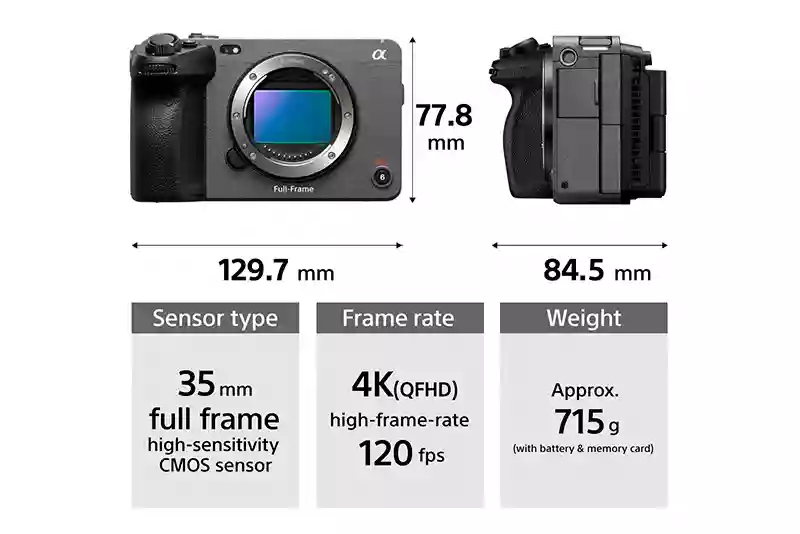
This illustration shows just how compact and lightweight the FX3 is
The FX3 is the newest of these three video bodies and manages to combine some of the best features from both of the other cameras into one seriously compact body. It does perhaps have more in common with the technology found in the a7S III, but hones in further on video production with pro XLR audio inputs, tally lamps, an integrated cage (screw holes for mounting accessories), shake meta data and a Zoom lever for starters.
Movie recording capabilities are identical between the FX3 and a7S III, which is really testament to the quality available in the mirrorless hybrid body. Both will record 4K 120p and FHD 240p for ultra smooth high resolution slow motion playback, with just a 10% crop in 4K. This captures video with delightful scenes where the action is slowed by up to 5x or 10x respectively. Both can also record 10-Bit 4:2:2, Long GOP, All-I compression with H.264 and H.265 codecs. External HDMI recording is available at 16-Bit RAW for endless depth and tonal range, with Sony's own S-Log3 and S-Cinetone™ profiles straight from camera. Users who colour grade and pull up shadows or reign in highlights have endless flexibility with these widely used colour profiles, which can create cinematic looks for any production.
Another similarity is in-body stabilisation, which together with the identical high ISO capabilities ensure users get more stable footage even in low lighting. ISO can be extended to 409,600 although we generally prefer to stick with native ISO where possible. 5-axis stabilisation works extremely well, particularly when using lightweight bodies of these kinds. Power comes from the same popular NP-FZ100 battery which has proven itself time and time again over the last couple of years. Sony has definitely learned from customer feedback where power is concerned.
This is just about where similarities end with some glaring omissions ensuring the FX3 is directly aimed at video content creators rather than being a hybrid camera. These include the fact there is no EVF to shoot and compose. This brings us on to key difference between Cinema cameras and mirrorless cameras, with the a7S III being a video-centric hybrid, whereas Cinema line are aimed squarely at movie makers.
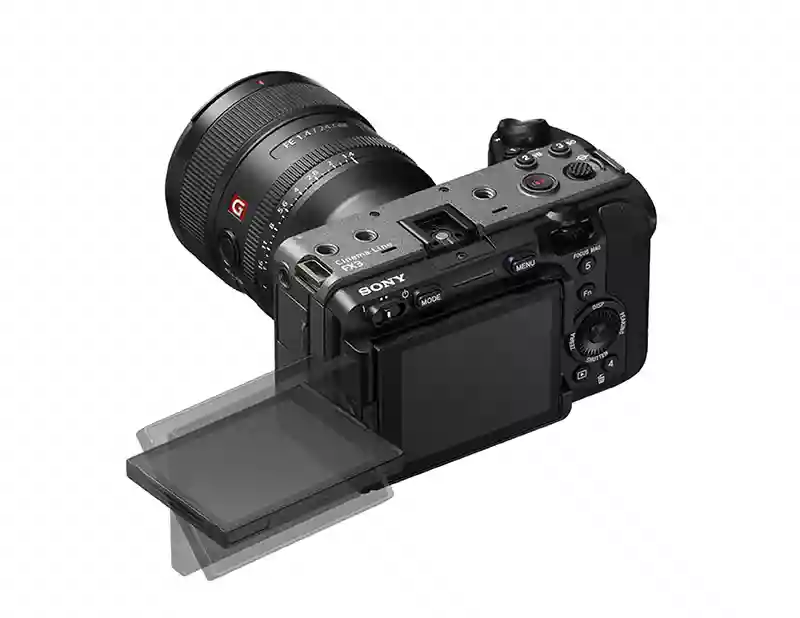
Look at me, a fully articulating selfie-style touchscreen LCD
The grip on the FX3 is deeper and the camera also comes with a detachable top mounted handle which can be mounted onto the integrated cage. This is a very nice touch and has enabled Sony to add XLR audio inputs whereas inputs on the a7S III are 3.5mm. The handle also provides a compact and stable way of hand-holding the camera, suited to the target audience of solo film makers, Youtubers and content creators who shoot predominantly on their own.
The rear of the camera also differs, with quick access buttons to focus settings on the main command dial including focus peaking and zebra patterns as well as a dedicated focus magnifier wheel.
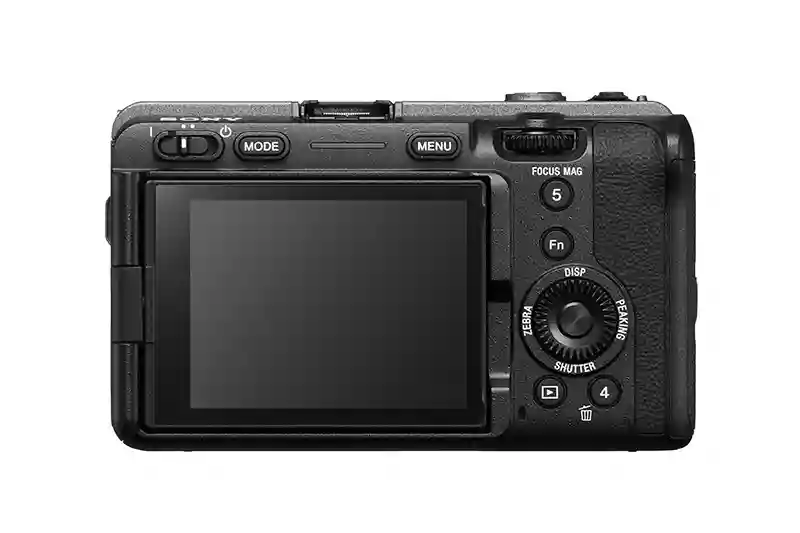
What’s the difference between the FX3 and FX6?
Certain features borrowed from the a7S III set the FX3 apart from its’ own big brother and might sway videographers who shoot for Youtube or create run and gun videos predominantly on their own. Namely these are the superb low light capabilities, in-body stabilisation and Eye AF tracking capabilities. All of these are aimed at making it easier to create better quality videos when shooting solo without gimbals, stabilisers and focus pullers for example, stemming from Sony’s development of their mirrorless Alpha cameras. The weight difference is also fairly considerable with the FX3 weighing 250g less than the FX6 as well as being smaller.
Whilst the FX3 may be aimed at individual content creators or as a B roll camera for a production agency, the FX6 holds its’ own across most video applications. With DCI-4K it offers slightly wider Cinema 4K format, as well as a higher resolution LCD screen at 2.76M dots.
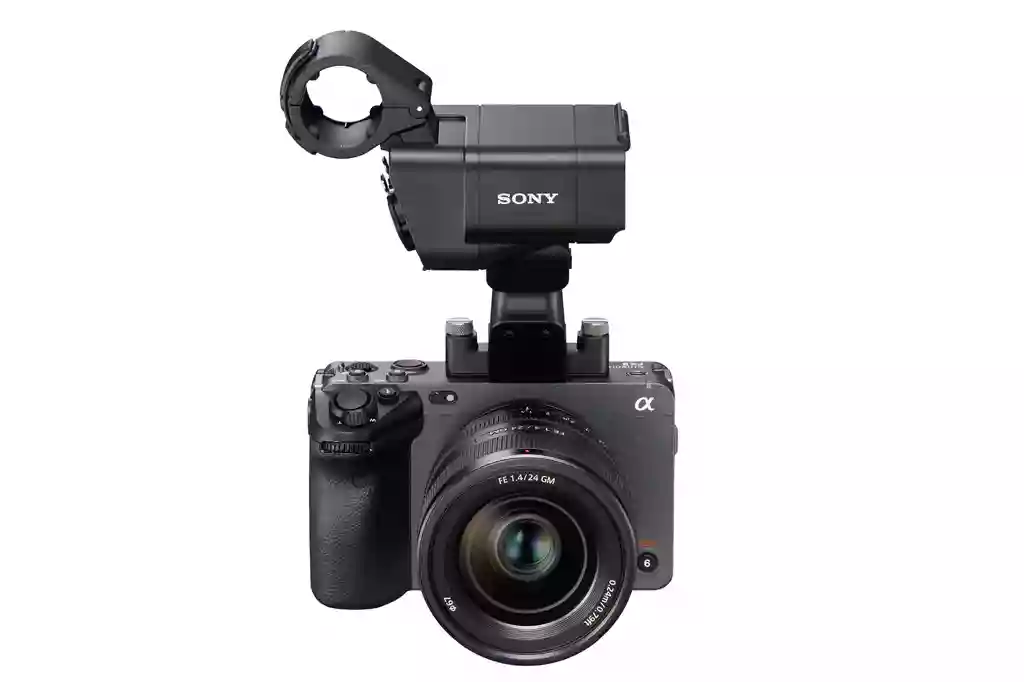
Built-in variable ND filters in the FX6 reduce the need for third party filters, allowing videographers to change filters according to light levels more swiftly from within the camera. Multiple cameras can also be aligned with the inclusion of TC In and Out. This kind of feature is definitely aimed at productions where several cameras will be recording at the same time, rather than flying solo as likely with the FX3.
The modular Smart handle and smart grip from Sony are also interchangeable with other cameras and suggest that the FX6 user base targets larger productions with more cameras on set. Audio capabilities are identical between the two Cinema Line options, with high quality XLR inputs available for both to capture excellent 4 channel 24 bit sound.
Watch our Youtube video review of the FX3 camera here
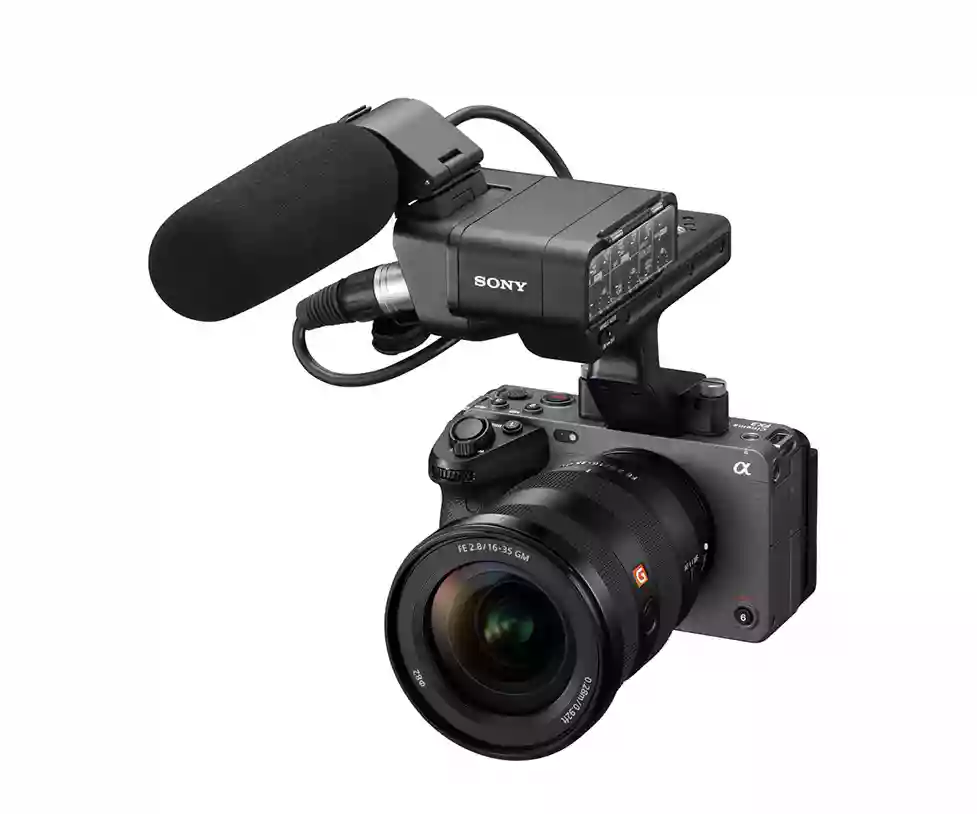
Final thoughts
Hybrid shooters should with little hesitation choose the a7S III. It is the bees knees in terms of video capabilities in a mirrorless body, so if you need easier compositions of still images that’s the way to go. Neither of the Cinema Line cameras have an EVF. This does come down to choice of body-style to some degree too. Some love the ‘brick-style’ form factor of Cinema cameras.
However for users who need photographs and are satisfied shooting with an LCD the choice becomes tougher as the lines are somewhat blurred between the FX3 and FX6. That said, individual film makers who work mostly on their own, will inevitably lean towards the more compact FX3 if they want the highest production capabilities without a full-blown multi camera set-up. The new body is superbly versatile with included codecs, stabilisation, AF tracking and so much more, which mirrorless users have become accustomed to. Production levels can go through the roof with all that technology on hand, not to mention pro audio and that ultra fast processor.
Multi camera production set-ups will inevitably favour the FX6 with its' Cinematic 4K resolution, full camera and lens control and other features aimed at pro productions.
All three models utilise Sony’s full frame E mount lenses giving users a comprehensive range of primes and zooms to suit their purposes. As video lovers, we also carry a broad selection of Sony compatible Cine lenses which will fit any of these three models. These provide movie-specific features with bright apertures and are predominantly primes aimed at getting the best movie quality out of any sensor.
For those who need more information you can get the full lowdown on the Sony a7S III specs here in our blog, which might be useful if you are still on the fence as to which camera suits your style of shooting best.
Share this post:
By Nick Dautlich on 23/02/2021
Nick Dautlich
Senior Content Writer and Product Reviewer
Nick Dautlich is the Senior Content Writer and Product Reviewer at Park Cameras, with over 15 years of photography experience. A Sony Imaging Professional and expert reviewer, Nick has worked with major brands such as Canon, Sony and Nikon. His work is also featured on Vanguard World UK’s website, Capture Landscapes, and Shutter Evolve. Nick’s photography includes National Trust projects and magazine covers and he is passionate about landscapes and storytelling. Nick also enjoys hiking and teaching his children about nature. Learn more on his profile page.

Trade in your old equipment
Fast and easy trade in service ensures your old gear is collected efficiently and you are paid quickly! It's very simple to trade in your unwanted photography gear. Just head over to our dedicated Sell or Part Exchange page, fill out the details, and we'll get back to you with an offer for your old gear. Take the cash, or put it towards the cost of your new gear. It's up to you! Find out more
sign up to the newsletter
Keep up to date on the latest photography news, events and offers. Sign up now